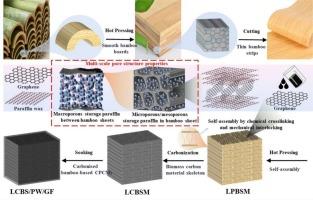Graphene-integrated bamboo biochar with enhanced anisotropic heat transfer for directional solar-thermal energy storage
IF 5.1
3区 材料科学
Q2 MATERIALS SCIENCE, COATINGS & FILMS
引用次数: 0
Abstract
The study of anisotropic composite phase change materials (CPCMs) is crucial for enhancing the efficiency of solar energy storage and conversion. However, existing directional CPCMs exhibit limitations including complex fabrication processes, low heat transport and poor stability, constraining their development and application. In this work, a simple and mechanized method based on flattening, slicing, spraying, self-assembly and carbonization technology is developed for the preparation of lamellar carbonized bamboo skeleton materials with enhanced directional thermal transport, which realizes the directional bonding arrangement of graphene and avoids agglomeration. The skeleton material exhibits a macroscopic, mesoscopic, and microscopic pore structure and excellent radial mechanical compression properties, and the porosity reaches 76.6 % without the need for chemical reagents. An anisotropic high-efficiency photothermal lamellar carbonized bamboo-derived CPCM is successfully developed by vacuum impregnation using paraffin as phase change material (PCM), and the heat storage density is as high as 108.25 kJ·kg−1. Based on this method, the longitudinal thermal conductivity and anisotropy of oriented CPCM are also synergistically improved, reaching 1.39 W·m−1·K−1 and 2.017, respectively. The significant anisotropy improves the directional transport and storage of solar heat and reduces heat loss. Additionally, the addition of graphene increases the light absorption of the CPCM to 98 %, resulting in a solar thermal storage efficiency of 91.25 % under 1.6 solar radiation intensities. Meanwhile, the shape-stable CPCM's excellent permeability resistance and stability promote its application in practice. The work has broad application potential in the application of medium and low temperature solar heat storage.

具有增强各向异性传热的石墨烯集成竹生物炭用于定向太阳能热储能
研究各向异性复合相变材料(CPCMs)对提高太阳能储能和转换效率具有重要意义。然而,现有的定向cpcm存在制造工艺复杂、热传递低、稳定性差等局限性,制约了其发展和应用。本工作开发了一种基于压平、切片、喷涂、自组装和碳化技术的简单机械化方法,用于制备具有增强定向热输运的层状碳化竹骨架材料,实现了石墨烯的定向键合排列,避免了团聚。该骨架材料具有宏观、介观和微观孔隙结构,具有优异的径向力学压缩性能,无需化学试剂,孔隙率可达76.6%。以石蜡为相变材料(PCM),采用真空浸渍法制备了各向异性高效光热片层碳化竹基CPCM,其储热密度高达108.25 kJ·kg−1。基于该方法,定向CPCM的纵向导热系数和各向异性也得到了协同改善,分别达到1.39 W·m−1·K−1和2.017 W。显著的各向异性改善了太阳热量的定向传输和储存,减少了热损失。此外,石墨烯的加入使CPCM的光吸收率提高到98%,从而在1.6太阳辐射强度下的太阳能储热效率达到91.25%。同时,形状稳定的CPCM具有优异的抗渗透性能和稳定性,促进了其在实际中的应用。该工作在中低温太阳能蓄热应用中具有广阔的应用潜力。
本文章由计算机程序翻译,如有差异,请以英文原文为准。
求助全文
约1分钟内获得全文
求助全文
来源期刊

Diamond and Related Materials
工程技术-材料科学:综合
CiteScore
6.00
自引率
14.60%
发文量
702
审稿时长
2.1 months
期刊介绍:
DRM is a leading international journal that publishes new fundamental and applied research on all forms of diamond, the integration of diamond with other advanced materials and development of technologies exploiting diamond. The synthesis, characterization and processing of single crystal diamond, polycrystalline films, nanodiamond powders and heterostructures with other advanced materials are encouraged topics for technical and review articles. In addition to diamond, the journal publishes manuscripts on the synthesis, characterization and application of other related materials including diamond-like carbons, carbon nanotubes, graphene, and boron and carbon nitrides. Articles are sought on the chemical functionalization of diamond and related materials as well as their use in electrochemistry, energy storage and conversion, chemical and biological sensing, imaging, thermal management, photonic and quantum applications, electron emission and electronic devices.
The International Conference on Diamond and Carbon Materials has evolved into the largest and most well attended forum in the field of diamond, providing a forum to showcase the latest results in the science and technology of diamond and other carbon materials such as carbon nanotubes, graphene, and diamond-like carbon. Run annually in association with Diamond and Related Materials the conference provides junior and established researchers the opportunity to exchange the latest results ranging from fundamental physical and chemical concepts to applied research focusing on the next generation carbon-based devices.
 求助内容:
求助内容: 应助结果提醒方式:
应助结果提醒方式:


